
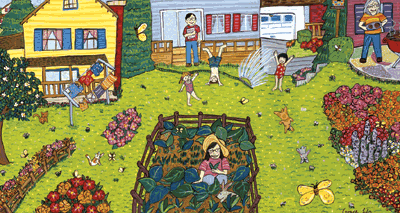
In this picture book, Grace features herself and her mother. In her later books, she would also include her two sisters, especially after they were upset about not making an appearance in this work. The setting of Grace's first picture book is in a suburban neighborhood and the main character little girl is embarrassed about the vegetables her mother grows in their garden. The vegetables are Chinese vegetables, and do not look anything like the beautiful flowers that the others grow nearby.
Awards: An American Booksellers Association's "Pick of the List"
A Bank's Street College Best Books of the Year
Nominated for the California Young Reader Children's Choice Award
Named a Growing Good
Kids Book Award CLASSIC.
Themes: owning one's heritage and being proud of where you come from (Dumpling Days, The Year of the Dog, The Year of the Rat)
Also: community and diversity
Dim Sum for Everyone (2001)
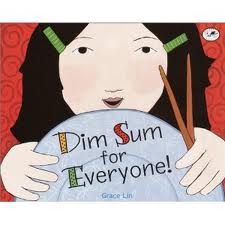
Dim Sum for Everyone (Knopf, 2001) takes place in Boston’s Chinatown and is about one family’s outing to a restaurant. The family includes 3 sisters, just like Grace’s! When you open the cover of this colorful book, there are several pictures showing various ingredients that are used in dim sum dishes. The family sits down to dinner and selects what they would like to eat from the silver carts that pass by. They select from different dumplings, cakes, buns and tarts. And then they share their food with one another so that everyone gets a taste of a variety of samplings. Mmmm! Turn to the last page of the text and what do you find? Empty little dishes!
Ingredients in dim sum dishes:
Soy sauce, eggplant, bok choy, water chestnuts, coconut milk, rice vinegar, mushrooms, scallions, daikon, tofu, sesame oil, tapioca, taro, snow peas, ginger, garlic, bell pepper, carrots, sesame seeds, shrimp, star anise
The story is short and simple and would be a valuable addition to any K-3rd classroom, especially if there is a need to discuss diversity or the Asian culture. The end of the book provides a valuable and short history lesson on dim sum that could be understood by the young elementary student. The illustrations are bright and colorful and stand out well against the red background of the dim sum restaurant. Grace Lin also makes use of her drawing skills to show the texture and patterns of the clothing and food. The characters are large and fill up each page making you feel as if you are there in the dim sum restaurant with the family as they enjoy their meal!
The back cover includes pictures of various dim sum dishes, such as sweet pork buns and egg tarts.
Did you know…
dim sum means little hearts or touches the heart in English?
that Grace Lin went out to eat dim sum at least 40 times for research while writing and illustrating this book?
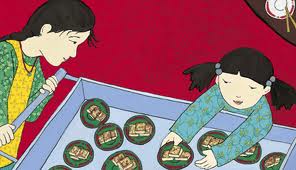
Kite Flying (2002)

In this picture book for grades preschool to 3rd grade, Grace depicts one family's fun of making and flying their own Chinese dragon kite. The whole family starts off together by going to the craft store to get supplies for their kite. This is the same family from Dim Sum for Everyone, Thanking the Moon, and Fortune Cookie Fortunes, and like in those books, every member of the family is important and has a job to do. By each member of the family doing their job, the whole kite comes together and is soon ready to fly. Like in the previous picture books which feature this family, the sentences are brief and the illustrations do most of the talking. The illustrations once more show patterns in the backgrounds, especially in the wallpaper and floors. There are bright colors and close ups of the family just like in the other picture books as well. The sky background (which Lin frequently uses because of Van Gogh's Starry Night painting) has swirls that had to the visual interest of the illustrations. Also as in the other picture books of this family, the inside covers show us pictures of items we might need to go kite flying and there is also a short history about kite flying at the end of the text. A wonderfully interesting read for all ages!
Okie Dokie, Artichokie! (2003)

Olvina Flies (2003)
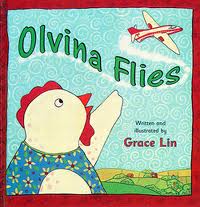
In this picture book for grades preK to 3rd, the main character, Olvina the Chicken, is to chicken to fly! On an airplane, that is! The plot of this story begins when Olvina gets an invitation from the Tenth Annual Bird Convention in Hawaii to attend, Olvina doesn't want to go because she can't fly and she would have to get on an airplane to go over the Pacific. "'Oh, Olvina," Will moaned. 'Don't be such a chicken.'" Will the Pig is Olvina's encouraging friend, one of the supporting characters in the book. Written in the 3rd person, as the reader we are let in on a lot of jokes, but through the text and the illustrations. When Olvina is buying her tickets for the airplane, there is a special discount for birds who buy airplane tickets because the airline doesn't get many bird passengers. On the airplane, Olvina meets another supporting character: Hailey the Penguin, also a bird who can't fly. The book's setting starts out in Olvina's home, but quickly and logically moves to the airport and then the airplane, where she meets Hailey. Hailey and Olvina become friends on the plane as Hailey shares some flying secrets with Olvina such as using gum to help clear the popping in your ears. Who knew a bird needed to know such things? Olvina learns that flying's not so bad, and she even made a new friend in the process. She sends Will back a postcard at the end of the picture book that says, "Flying was easy!"
Visual jokes fill the pages: a deer flight attendant sports the name "Doey"
A mouse rides the security conveyor belt with his suitcase,
A monkey claims his bunch of bananas in the airport
When looking at these illustrations, you can tell they are from the same author. There again is a lot of red used in the illustrations, although not as much as in Dim Sum for Everyone. Olvina's comb on her head is even red. The pictures are also bordered by red as well.
Text: More complex and detailed than in Dim Sum for Everyone or Fortune Cookie Fortunes.
Bibliotherapy: This picture book is great for first time fliers. It shows all the steps of how to fly on a plane such as arriving at the airport and going through security. We also feel for Olvina when she puts her ticket in her suitcase and has to find it, unintentionally showing her polka-dotted underpants inside her suitcase!
This picture book also shows kids that they are not the only ones who can't do certain things. Olvina can't fly and she feels bad about it. But she tries something new and meets someone just like her who can't fly. She also makes a new friend. This idea comes across in Grace Lin's life when she felt that she was the only Asian child in her town besides her two sisters. In junior high, Alvina moved to her town. Alvina was also Asian, and she and Grace soon became close friends. Today they are still friends and Alvina is even Grace's editor when she writers her books!

Robert's Snow (2004)
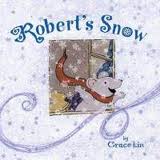


Jingle Bells (2004)
Fortune Cookie Fortunes (2004)
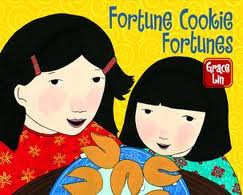
Deck the Halls (2004)

The Twelve Days of Christmas (2004)
Merry Christmas! Let's All Sing! (2005)

The Year of the Dog (2006)

Our Seasons (2006)

Olvina Swims (2007)
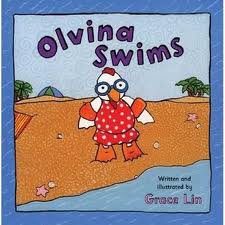
Olvina is back and ready to learn some new lessons!! Olvina the Chicken is the same main character from Olvina Flies and in this event of her life, she is not afraid of flying, but she is now afraid of swimming! The picture book for preschool to 2nd grade, teaches how Olvina stops being a chicken and learns how to swim. Her friend Hailey the Penguin that she met on the plane to Hawaii is here to help her get over her fear. Hailey loves swimming in the ocean (as most penguins do!) and she wants Olvina to join her. Olvina is emphatic that "chickens don't swim," but Hailey is unrelenting. Hailey's idea is to help Olvina gradually get over her water fear. They first get Olvina to get into the bathtub, then the swimming pool, and finally....Olvina attempts the ocean!! This picture book is great for kids because Olvina learns to love the water at the same time that a friend is helping her out.
Illustrations: Like in Olvina Flies, the illustrations show some visual jokes like the fish in the ocean who wear top hats. Lin uses gouache paintings again, and like in her other picture books, Line uses patterns in the borders and clothing. The colors are bright and cheerful; great for the setting of the seaside.
The Red Thread: An Adoption Fairy Tale (2007)

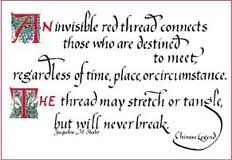
Lissy's Friends (2007)
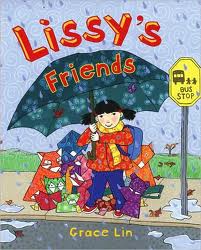
The Year of the Rat (2007)

Bringing in the New Year (2008)
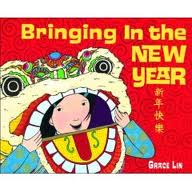
Where the Mountain Meets the Moon (2009)

Thanking the Moon (2010)

The family from Dim Sum for Everyone, Kite Flying, and Fortune Cookie Fortunes is back! The characters of this story follow one little girl's family, which includes the characters of Ma-Ma, Ba-Ba (father), and sisters Mei-Mei and Jie-Jie. The story is told in first person, so we don't know the narrator's name, but it very well could be taken from some of Grace Lin's experiences as a child. The first sentence of the tale, "The mid-autumn moon glows in the sky. We got into the night to admire it," takes us into the experience of one family's celebration of the Mid-Autumn Moon Festival, a common celebration amongst Asian families, just like the Chinese New Year. The text is simple, just like Dim Sum for Everyone and Fortune Cookie Fortunes and much of the plot of the story is told through the pictures as the family prepares for their picnic under the moonlight. They prepare and eat mooncakes and pomelos, and then drink tea to wash it down. Lanterns are hung under the moonlight and as the story ends, each family member thanks the moon and sends up a secret wish. The story peacefully ends with the line, "[The moon] peacefully watches over all of us..." This would make a great bedtime story for young kids and could also be used to teach kids about an Asian tradition that may not be as familiar to a lot of people.
Illustrations: Unlike Dim Sum for Everyone, the main background color in this text is blue. This serves to really make the bright moonlight stand out. Like in Dim Sum, the illustrations are close ups of the family's faces, making us feel as if we are having the picnic with them. There are patterns again in the illustrations such as in the clothing and swirls that occur lightly in the night sky.
The book ends with information about the Moon Festival traditions.
Like Dim Sum, the inside cover has things one would need for a Moon Festival picnic: a book of Chinese poetry, a tea set, smiling steamed cakes, a picnic blanket, glow
sticks, lanterns, candles, Asian pears, an honor table, a rabbit statue, pomelos,
and moon cakes.
Another book about the moon (like her previous novel)!
Dumpling Days
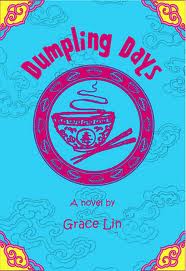
This novel, like The Year of the Rat and The Year of the Dog, is based on Grace Lin's childhood experiences. The main character, Pacy, is even supposed to be Grace as a young girl since her nickname was also Pacy. After traveling to both China and Taiwan in 2009, Grace Lin had to use these inspiring settings in a novel. Using her family's experiences of a trip to Taiwan and then her own travel research as an adult, Grace gives us a middle grades novel that is both humorous and insightful. Pacy learns about making friends in this novel, but unlike the other novels featuring Pacy and Grace's other picture books about making friends (Olvina Flies or Lissy's Friends), Pacy doesn't actually make a new friend in the story. Instead, by the end of the book, Pacy realizes that she shouldn't have spent her time focusing on someone who was making her life miserable. She instead realizes that her focus should have been on another girl in her painting class who both enjoyed the painting class and who seemed to be a lot of fun. Because she didn't realize this soon enough, Pacy missed out on meeting a new friend.
Like Where the Mountain Meets the Moon and Olvina Flies, the main character (Pacy) must go on a journey to find out more about herself. Pacy's family travels to Taiwan for a whole month to visit their family. Pacy's parents, just like Grace's, are Taiwanese immigrants to the U.S., so they want to go back to see their families and to specifically see their grandmother who is turning 60 (which is a big deal in Asian cultures that use the Chinese calendar!). Pacy's mother signs her up for a Chinese painting class and the family's adventures in Taiwan are also told. Pacy realizes that it's hard not knowing the language and that people tend to ignore her because she can't speak Taiwanese or Chinese.
Some humorous incidents in the novel include: Pacy accidentally eating chicken feet (seriously), getting accidentally blessed by a fortune teller, and getting lost in the Taipei night market!!
Ling & Ting: Not Exactly the Same! (2011)
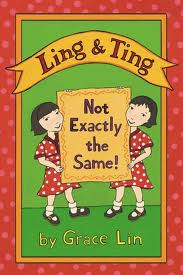
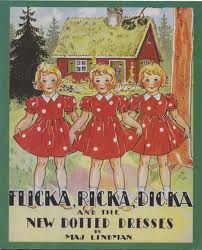
- Grace’s first and only early reader so far
- Inspired by the old Flicka, Ricka and Dicka books Grace read when she was young.
- Awarded with the Theodor Geisel Honor in 2011.
This early reader focuses on a set of Asian American twins names Ling and Ting. Asian American twins. The sentences are simple, less then ten words a piece. The concepts are simple as well, but this would be a great book for the beginning reader because of the repetition in the text and also because of the introduction of Asian culture. The very first short chapter introduces the reader to why Ling and Ting do look alike (they are twins), but why they do not look exactly alike - Ting sneezes while getting a haircut and her bangs are cut too short. Through the rest of the book we can tell apart the twins because Ting's hair is still cut crooked. Grace Lin uses patterns again in the illustrations by making the girls' dresses colorful and patterned. The cover illustration is even modeled after the above cover illustration since Grace used the Flicka, Ricka, Dicka books as an inspiration for Ling and Ting.
The illustrations in this book are not as complicated and eye-catching as those in Grace's picture books. More of the story is told through the words. This is also evident in Grace's novels, like in Dumpling Days, where the illustrations are even less complicated and tell less of the story.
Theme: How we can look the same, as with twins, but still be different.
Dumplings again! (Also in Dumpling Days and Dim Sum for Everyone!)
Starry River of the Sky
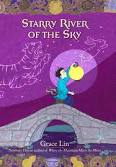
Themes: making friends (Grace making friends with the new Asian girl, Alvina)
Olvina flies
Lissy's Friends
Trying new things
Olvina Flies
Olvina Swims
Dumpling Days
Journey (Grace Lin's journey to find the Asian side of herself. Grace's travels to Asia)
Dumpling Days
Where the mountain meets the moon
Owning one's heritage and being proud of where you come from
Dumpling Days
The Year of the Dog
The Year of the Rat
Settings: Under the moon, Taiwan, Hawaii, faraway kingdom
Recurring Characters:
Family in Dim Sum for Everyone, Kite Flying, Thanking the Moon, and Fortune Cookie Fortunes
Pacy Lin and family in Dumpling Days, The Year of the Dog and The Year of the Rat
Olvina the Chicken in Olvina Flies and Olvina Swims
Illustrations: use of patterns
Olvina flies - polka dots
Dim Sum for Everyone
Kite Flying
Thanking the Moon
Ling & Ting - polka dots
Critical Analysis of Grace Lin's Works
Grace Lin began her children’s writing career as an illustrator. Her first goal was to illustrate children’s books, never thinking about writing a story to go along with her pictures. That was until her first editor saw her illustration titled, The Ugly Vegetables. When he asked her if she had story to go along with it, she said of course, and then she raced home to complete her first book within the week. That book became the popular picture book, The Ugly Vegetables, published in 1999. This is one of Grace’s most famous and popular books and has won such accolades as the Growing Good Kids Book Award CLASSIC, the ABA Pick of the Lists, Fall 1999, the nomination for the California Young Reader Children's Choice Award, the winner of the 2002 Austin Young Engineers Book Award for Fiction Gr. K-2, a notable Social Studies Trade Books for Young People for 2000, and a pointered Kirkus Review. From this short and sweet picture book we can see Grace’s writing style begin to come across.
In her picture books like Dim Sum for Everyone, Kite Flying, and Fortune Cookie Fortunes, Grace uses minimal text and simple words to convey her story. She uses her skills as an illustrator to tell much of the story. The pictures tend to be close ups of the characters faces, making the reader feel like part of the action. In Dim Sum for Everyone, the reader can feel like they are actually in the dim sum restaurant with the family! Grace also uses a lot of patterns in her illustrations. She has said before that her use of patterns and swirls probably comes from her love of Van Gogh’s painting Starry Night. In Kite Flying we can see swirls in the night sky just like in Van Gogh’s painting.
Grace is also quickly winning many other awards for her books and is also becoming more recognized, especially as being a source for multicultural texts dealing with the Asian-American culture. Dim Sum for Everyone gained such accolades as a Starred Booklist Review, a Starred Kirkus Review, a Parent's Guide 2001 Children's Media Award Winner, a CCBC Choices 2002 award, and a Best Picture Books of 2001 nod voted by the Baltimore County Public Library. Several of her other books have also won awards as well. Her first early reader, Ling & Ting, won a 2011 Theodor Geisel Honor and one of her latest novels, Where the Mountain Meets the Moon, won a Newbery Honor Award. Grace’s books are quickly becoming more popular and are also being used to help families who have adopted from Asia. Her book titled The Red Thread, has been used to help other to understand the adoption process. Her other books that focus on the Asian culture are also being used by American families to teach their adopted children about their birth culture.
In examining her picture books about one Asian-American family’s experience, we can see commonalities of words and pictures that run through this series of books. In Thanking the Moon, Grace begins her story by making the setting clear from the start: “The mid-autumn moon glows in the sky. We go into the night to admire it.” The setting is outside under the moon, which we know quickly from the very first short sentences. The illustrations also show us clearly how this story will begin and could stand alone in telling the beginning of this story. In Dim Sum for Everyone, Grace Lin begins this short and sweet story with another clear and direct first sentence: “Dim sum has many little dishes.” We know right away, using clues in the illustration and the first sentence that our setting will be in a dim sum restaurant. Grace’s style is unique because of her use of Asian topics that are not frequently found in American literature. Who has ever heard of a children’s picture book focused on a dim sum restaurant? In her other books featuring this family, Kite Flying and Fortune Cookie Fortunes, Grace uses the same techniques of concise, but precise, text to convey her meaning. She also puts a lot of emphasis in her illustrations to get across her meanings. Just like in Thanking the Moon, Grace again uses patterns and swirls to add texture to her paintings in Dim Sum for Everyone. The red floor background has swirls like in the night sky of Thanking the Moon. The characters’ clothing has patterns and bright colors, which add to the excitement and thrill that the family and reader feels in experiencing the dim sum restaurant.
These picture books that focus on this Asian-American family also use a particular format that is evident throughout the books. They start off with what Ma-Ma does, as in Dim Sum for Everyone: “Ma-Ma picks little dishes of sweet pork buns.” Grace then tells us what Ba-Ba (father) does, then Jie-Jie and Mei-Mei, and finally the narrator herself. Knowing that there is a formula to the story would be comforting to the young reader. It also keeps with the theme that each member of the family has a specific role/job to fulfill that is important to the story and also to how the family operates.
Grace did not just stick to picture books, although she does a wonderful job with these, especially the illustrations. She soon branched out to her first early reader: Ling & Ting: Not Exactly the Same. In the past few years, Grace has also begun to write novels for middle grade readers, most of which are based on her own life. She uses experiences from her family’s life (like she does in her picture books) as inspiration for these novels. Pacy Lin, who is based on Grace as a child, is the main character in the novels The Year of the Dog, The Year of the Rat, and Dumpling Days. In Dumpling Days, Pacy and her family travel to Taiwan, just like Grace’s family did when she was a child. Many of the events that occur in the novel are based on events that happened to Pacy and her family. In these novels, Grace Lin is seemingly being more frank about what it is like to be of Asian ancestry. The picture books that deal with being Asian do so from only a surface standpoint: only traditions are told about; there is very little about any kind of negativity. The novels are different, which show how Grace Lin is developing as a writer and being more frank about who she really is. The main character in Dumpling Days talks about being called a “Twinkie” and how she at times doesn’t feel Taiwanese. She also experiences what it’s like to not be considered American in the U.S., but also not to be considered Taiwanese when she’s in Taiwan. She feels what it’s like to be looked down upon because she and her sisters were not taught to speak Taiwanese or Chinese – she has become “Americanized.”
One of the themes that comes across in Grace’s books is that of making friends. In Olvina Flies and Lissy’s Friends, the main character has to deal with trying something new (going on an airplane or starting a new school) and doing so without knowing anyone there. Both characters realize that they are not so different from everyone else and they are able to make a new friend. Grace Lin experienced making a new friend like herself when she became friends with Alvina, who moved to Grace’s junior high school and was the only other Asian girl in town beside Grace’s two sisters. Another theme in Grace’s works is that of trying new things. The character of Olvina the Chicken tried both flying on an airplane and learning how to swim in the picture books about her. And in Dumpling Days, Pacy Lin has to try many new things just because she’s in a new country. She accidently eats chicken feet, she learns to paint the Chinese way, and she explores all that Taiwan has to offer.
Going on a journey is another theme that spans Grace Lin’s works. Grace herself went on a journey literally when she traveled several times to Asia. But she also went on a journey to “find herself” as she learned to embrace her Asian heritage. The theme of a journey is also found in Dumpling Days and Where the Mountain Meets the moon. Grace’s embracing of her Asian background also comes across in The Year of the Dog and The Year of the Rat, both of which tell about Pacy’s gradually understanding of what it means to be an Asian-American.
Grace Lin’s works are unique and memorable for readers because her perspective, in her writing and illustrations, is not one that is typically found in American literature for children. Grace wanted to write about being Asian-American, and how we all have similarities and differences. Her writing is a great introduction to the Asian culture. Almost all of her writing deals with different Asian traditions and also is infused with a lot of great information and details. Her characters are easily approachable and easy to get to know. When reading about them, like in Dumpling Days for example, the reader feels as if they are experiencing life right along with Pacy. This is also true for Grace’s illustrations: they are closeups of the characters’ experience, which helps the reader to be closely intertwined with the character. Because of this closeness and familiarity, Grace Lin does a wonderful job of showing the reader that, although the Asian culture is unique and has traditions and events that are very different from others, there are still similarities. Pacy still gets scared when she gets lost in the Taipei night market. The Asian-American family in Grace’s picture books enjoy being together and enjoying their family traditions. Olvina still gets scared in trying something new. All of Grace’s writing gives a particular message that she seems to want to leave us with: we all have similarities and differences, but we can appreciate both in each other.Lin, G. (1999). The ugly vegetables. Massachusetts: Charlesbridge Publishing.
Lin, G. (2001). Dim sum for everyone! New York: Alfred A. Knopf.
Lin, G. (2002). Kite flying. New York: Knopf Books for Young Readers.
Lin, G. (2003). Olvina flies. New York: Henry Holt and Company.
Lin, G. (2004). Fortune cookie fortunes. New York: Knopf Books for Young Readers.
Lin, G. (2006). The year of the dog. New York: Little, Brown & Company.
Lin, G. (2007). Lissy’s friends. New York: Viking Publishing.
Lin, G. (2007). Olvina swims. New York: Henry Holt and Company.
Lin, G. (2007). The red thread: An adoption fairy tale. Illinois: Albert Whitman &
Company.
Lin, G. (2008). Bringing in the new year. New York: Knopf Books for Young Readers.
Lin, G. (2008). The year of the rat. New York: Little, Brown Young Readers.
Lin, G. (2009). Where the mountain meets the moon. London: Little, Brown Book
Group.
Lin, G. (2010). Ling & Ting: Not exactly the same! New York: Little, Brown and
Company.
Lin, G. (2010). Thanking the moon. New York: Alfred A. Knopf.
Lin, G. (2012). Dumpling days. New York: Little, Brown Books for Young Readers.